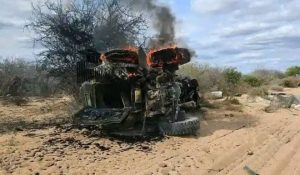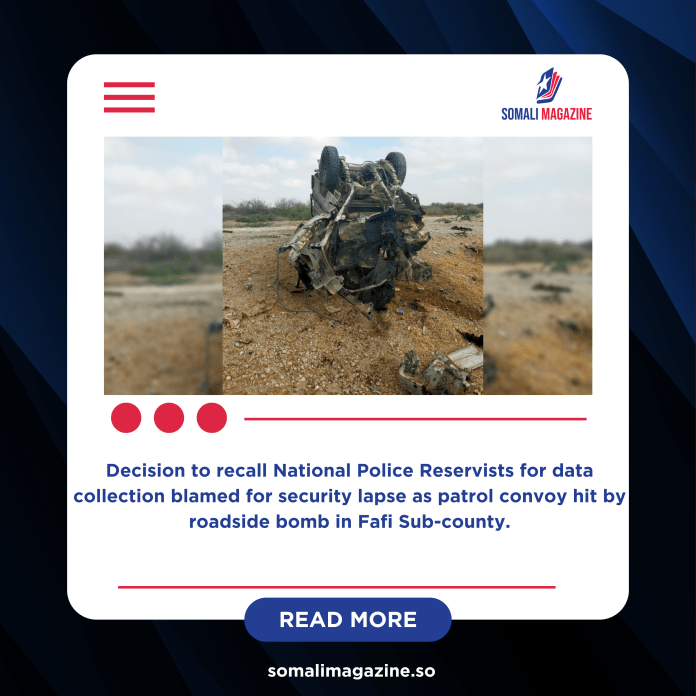Facebook Twitter (X) Instagram Somali Magazine - People's Magazine
At least eight police officers were injured on Tuesday in an IED (Improvised Explosive Device) attack in Garissa County, raising serious questions about a recent move by senior security officials to summon all National Police Reservists (NPRs) to the county headquarters for data collection.
The injured officers, all part of the elite Border Patrol Unit (BPU), were on a routine patrol in Fafi Sub-county when their anti-mine vehicle was struck by the explosive. The attack occurred along the Banane-Yumbis road, around 10 kilometres from Yumbis. Fortunately, no lives were lost, but the incident has sparked concerns about gaps in security coverage.
According to Fafi Sub-county Deputy County Commissioner Naftali Koojo, the officers were traveling in a convoy of three vehicles. The first two passed through the area safely, but the third vehicle, which was at the rear and carrying eight officers, was hit by the explosive. The blast caused the vehicle to overturn, and the officers in the first two vehicles quickly returned to assist their injured colleagues.
“All eight officers were rescued and taken to Hagadera Hospital for treatment,” Koojo confirmed. He added that arrangements were being made to transfer them to Nairobi for further medical attention.
Following the incident, questions arose about the presence—or lack thereof—of National Police Reservists in the area. NPRs are locally recruited and deployed in insecure regions to work alongside regular police and support security operations. They are especially important in remote and dangerous areas like Fafi, where regular police presence may be limited.

The absence of NPRs during the attack raised eyebrows, especially after reports emerged that senior security officials in Garissa had recently ordered all NPRs to report to the county headquarters for fresh data collection. Critics argue that this decision left vulnerable areas like Banane and Yumbis exposed to attacks.
When asked about the decision to summon NPRs, Mr. Koojo said he was not aware of such an order. He emphasized that NPRs are not stationed in one place permanently but instead move from one area to another as needed.
“These NPRs are not static. They operate across different areas depending on the situation. Also, the area where the attack happened—Garissa Yarey—is not inhabited,” Koojo stated, suggesting that the presence of NPRs might not have made a difference in that specific location.
Despite denying knowledge of the NPR summons, Koojo defended the working relationship between security agencies and the reservists. “We are working well with our NPRs in addressing insecurity,” he said.
Efforts to get comments from other senior security officials in Garissa were unsuccessful. Garissa County Police Commander Amos Ambasa said they were in a meeting at the Regional Headquarters and could not speak to the media.
The use of IEDs by militants, especially in northeastern Kenya, remains a persistent threat. This incident adds to a growing list of similar attacks targeting police patrols and convoys in the region.
Local leaders and security analysts are now calling for a review of the NPR deployment strategy, especially in high-risk areas. They argue that removing NPRs from their locations, even temporarily, weakens the area’s security structure and emboldens attackers.
The government continues to rely on NPRs to fill gaps in regions where the police presence is stretched thin. However, the effectiveness of this strategy comes into question when decisions like mass data verification end up pulling critical personnel away from the front lines.
As the injured officers receive treatment, the focus now shifts to how security operations in Garissa—and other vulnerable areas—can be better coordinated to prevent similar incidents in the future.

